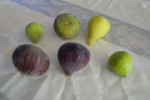I spent last weekend doing research for my book in the Western Galilee – an area of tremendous natural beauty which is quite off the tourism track, with villages that have long and illustrious histories yet are still relatively isolated from mainstream Israeli life. The foodways I was fortunate enough to encounter during this trip were so remarkable and impressive that ten blog entries could not describe them all. And the people who shared them with me – practitioners of the local food concept in the most authentic sense – were gracious beyond description.
In the Druze village of Hurfeish, we had lunch at the home of Nimmer Nimmer, a distinguished writer and translator. After our meal, he served us seven varieties of figs, explaining the names and characteristics of each one – including one “Bukkrati”, whose namesake, Hippocrates, invokes the medicinal properties of this particular variety.

When we spoke of the Biblical text describing every man under his vine and fig tree, Mr. Nimmer related the fig to another Biblical metaphor – pointing out that ripe figs drip both milk and honey.
In the village of Jish (Gush Halav), we met with M., a young schoolteacher with a strong ideological commitment to maintaining his family’s culinary traditions (along with a deep aversion to publicity), his wife and their five children. Jish is known for its figs, particularly the local variety known as “biyatti” – from the Arabic word for white (green figs – as opposed to purple figs, which are “black”), which survive and thrive with relatively little water.

M. and his family collect figs from the many trees growing around the village, and prepare dried figs pressed into cakes – an ancient preservation technique – syrup made out of figs, called “dibess” – so close to the Hebrew word “dvash” for honey – and “mahoud” – a kind of fig jam that is thick with sesame seeds and walnuts (all locally grown) – which they say is outstanding in both flavor and nutritional value – for that I will return to taste in September.

I came home with a cake of figs and a bottle of dibes. The fig cake is served in thin slices – with a flavor that only remotely resembles that of the dried figs from Turkey. And the dibess, following his wife’s suggestion, I will mix with tehina to make a fresh summer halva dip for sliced fruit.
Abbie, this all sounds fantastic !
Abbie, what a coincidence that your beautiful new year’s article about figs arrived in my in-box just as I was having a lovely daily ritual of eating a ripe fig each day for lunch with a blob of ripe soft cheese on it. Bliss! Happy new year!